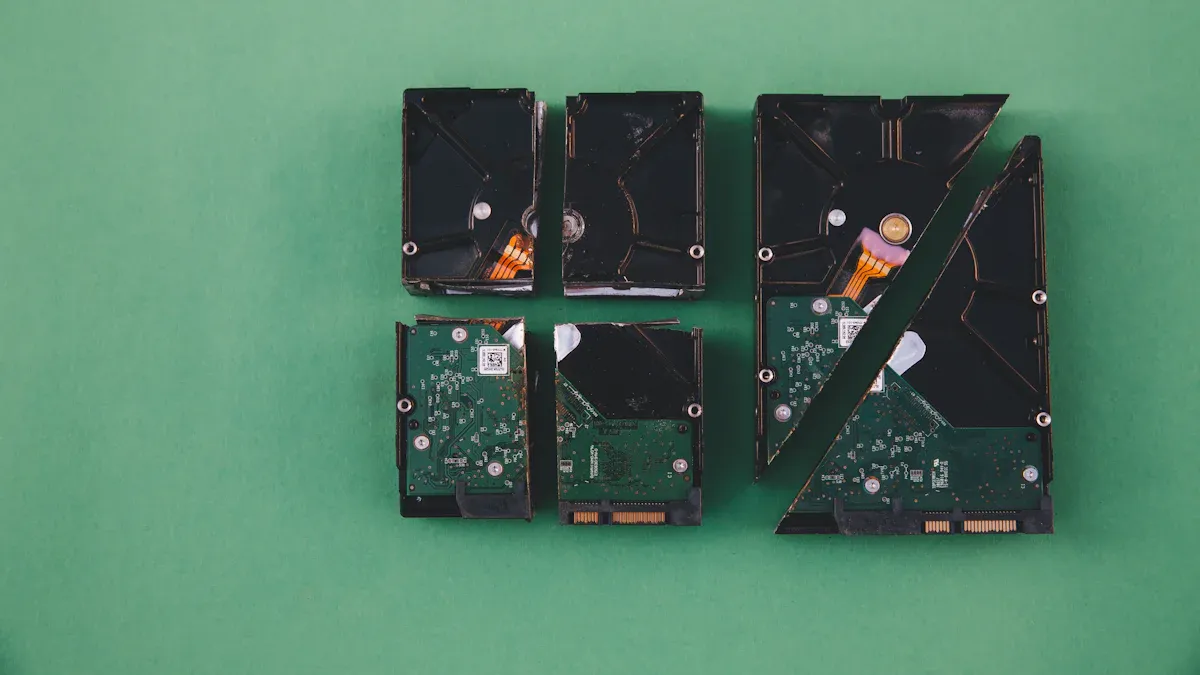
Solid-State Batteries set a new standard for powering humanoid robots in enterprise environments. You face unique challenges when deploying robots, as traditional lithium-ion batteries often fail due to issues like thermal runaway, short circuits, and overheating.
Operational Failure | Cause |
|---|---|
Thermal runaway | Physical damage, Over-charge |
Short circuits | Improper handling |
Overheating | Excessive charging/discharging |
Risks of fire/explosion | Flammable electrolyte, toxic gas |
Solid-state technology delivers safer operation, higher energy density, longer service life, and seamless integration—key factors for cost-effective, reliable robotic fleets.
Key Takeaways
Solid-State Batteries enhance safety by using non-flammable solid electrolytes, reducing risks of fire and thermal runaway.
Higher energy density in Solid-State Batteries allows humanoid robots to operate longer and carry less weight, improving efficiency.
Solid-State Batteries offer extended lifespan and durability, leading to lower maintenance costs and less downtime for robotic fleets.
Part 1:Solid-State Batteries: Safety & Performance

1.1 Enhanced Safety
You need batteries that keep your humanoid robots safe, especially when they operate near people or sensitive equipment. Solid-State Batteries use solid electrolytes instead of flammable liquid ones, which makes a significant difference in safety. Here’s how they protect your operations:
Solid electrolytes are non-flammable, so they eliminate the risk of fire or explosion caused by leakage.
These materials resist overheating, which reduces the chance of thermal runaway—a common cause of battery fires in traditional lithium-ion batteries.
Solid electrolytes act as both conductors and separators, keeping the anode and cathode apart and preventing short circuits.
The robust design allows for safer charging, even at high currents, which further reduces overheating risks.
Solid-state technology aims to eliminate thermal runaway entirely, making it a safer choice for robotics in environments like medical, security system, and industrial applications.
Predictive maintenance and safety strategies, such as Remaining Useful Life (RUL) estimation and accelerated degradation tests, further support operational reliability and risk mitigation.
Safety Feature | Solid-State Batteries | Lithium-Ion Batteries |
|---|---|---|
Flammable Electrolyte | No | Yes |
Risk of Thermal Runaway | Minimal | High |
Short Circuit Protection | High | Moderate |
Overheating Resistance | High | Moderate |
For more on battery safety research, see Nature Energy.
1.2 High Energy Density
You want your robots to work longer between charges and carry less weight. Solid-State Batteries deliver up to 2-3 times the energy density of conventional lithium-ion chemistries like LiFePO4, NMC, LCO, LMO, and LTO. This higher energy density means:
More energy storage per kilogram, with values reaching around 300 Wh/kg compared to 200 Wh/kg for lithium-ion.
Longer operational times for your humanoid robots, reducing the need for frequent recharging.
Lighter battery packs, which improve robot mobility and efficiency, especially in space-constrained designs.
Solid-State Batteries are recognized as next-generation technology for compact robotic platforms. Their high energy density and safety make them ideal for advanced Robotics and Consumer Electronics deployments.
Battery Chemistry | Energy Density (Wh/kg) | Typical Application |
|---|---|---|
Solid-State | ~300 | Humanoid Robots, Medical |
Lithium-Ion | ~200 | Consumer Electronics, Industrial |
1.3 Extended Lifespan
You need batteries that last through thousands of charge cycles, especially in high-frequency robotic environments. Solid-State Batteries offer a longer lifespan and greater durability than lithium-ion batteries. They can charge in minutes and withstand thousands of cycles, which means less downtime and lower maintenance costs for your fleet.
Battery Type | Cycle Life Range | Common Aging Mechanisms |
|---|---|---|
Solid-State Batteries | Double to lower triple digits | Volume change of the anode, mechanical stress, dendrite formation |
Lithium-Ion Batteries | Generally higher cycle stability | Cathode/electrolyte decomposition, SEI layer growth |
“Solid-state battery technology, with its promise of greater energy density, enhanced safety, and improved endurance, offers a glimmer of hope. However, until these innovations mature and break the existing energy density bottleneck, humanoid robots will remain tethered to short operational windows and safety concerns.”
You benefit from predictive maintenance and reliability models that help you plan for battery replacement and avoid unexpected failures. These features are critical for robots operating near humans and in demanding B2B scenarios, where safety and uptime are non-negotiable.
Evidence Description | Key Points |
|---|---|
Degradation Models and RUL Predictions | RUL estimation supports predictive maintenance and safety. |
Accelerated Degradation Tests (ADT) | ADTs improve reliability of RUL predictions. |
Common Causes of Battery-Related Incidents | Identifies risks such as mechanical damage and thermal stress. |
Mitigation Strategies | Outlines prevention and containment methods for battery safety. |
For more on battery longevity and predictive maintenance, see Science Advances.
Part 2:Integration Benefits

2.1 Compact Design
You want your humanoid robots to fit into tight spaces and operate efficiently. Solid-State Batteries offer high volumetric energy density, which supports compact robot designs. You can reduce the size of battery packs without sacrificing performance. This enables you to create robots with smaller footprints and more advanced features.
Benefit | Description |
|---|---|
Faster charging | Supports faster ion transfer with reduced risk of overheating, leading to shorter charge times. |
Greater safety | Eliminates flammable liquids, significantly lowering fire risks and thermal runaway incidents. |
Longer lifespan | Resists dendrite formation, maintaining performance over more cycles. |
Smaller, lighter form factors | Higher energy efficiency reduces the need for bulky components, allowing for more compact designs. |
2.2 Lightweight & Flexible
You need robots that move with agility and precision in Infrastructure and Industrial settings. Solid-State Batteries achieve a 40% weight reduction compared to conventional lithium-ion batteries. This lighter weight improves mobility and reduces energy consumption. Flexible battery designs allow you to optimize placement within the robot, enhancing stability and movement.
The battery capacity of Figure 02 is 50% higher than its predecessor, allowing for longer operational periods.
The battery’s placement within the torso enhances stability and agility, improving overall performance.
A balanced weight distribution contributes to the robot’s efficiency in movement.
The GR-2 features dexterous hands with 12 degrees of freedom, mimicking human flexibility.
Equipped with tactile sensors, it can sense force and adjust grip in real-time, enhancing handling in various environments.
The dual-rotating structure allows for flexible foot adjustments, enhancing motion stability on uneven terrain. This adaptability is crucial for applications in emergency rescue and rehabilitation.
2.3 Lower Total Cost
You want to minimize the total cost of ownership for your robot fleet in Consumer Electronics and Industrial deployments. Solid-State Batteries are projected to be priced similarly to conventional lithium-ion batteries. Simplified production processes may lower system costs. Although higher lithium requirements could increase material costs, the higher energy density often justifies these expenses.
Benefit | Explanation |
|---|---|
Enhanced Safety | Use of ceramic electrolytes eliminates risks of leaks or fires. |
Longevity | Service life of up to 20 years with minimal capacity loss allows for high uptime. |
Energy Efficiency | Higher voltages per cell reduce the number of cells needed, lightening robot design. |
Solid-State Batteries reduce maintenance and downtime, supporting high uptime for enterprise-scale deployments.
Solid-State Batteries deliver unmatched safety, performance, and integration for your humanoid robots. You gain operational efficiency, enhanced mobility, and long-term value.
Feature | Solid-State Batteries | Lithium-Ion Batteries |
|---|---|---|
Energy Density | High | Moderate |
Safety | Superior | Standard |
Lifespan | Extended | Limited |
You can scale deployments with longer operational hours and reduced maintenance.
Industry experts predict rapid adoption and transformative impact.
Environmental benefits support your sustainability goals.
Ready to optimize your robotic fleet? Request a custom battery solution for your enterprise.
FAQ
What advantages do Large Power solid-state batteries offer over lithium-ion battery groups?
Feature | Solid-State (Large Power) | Lithium-Ion Groups |
|---|---|---|
Safety | Superior | Moderate |
Energy Density | Higher | Standard |
Lifespan | Extended | Limited |
You gain higher safety, longer service life, and greater energy density for your robotic deployments.
Can you customize solid-state battery solutions for specific robotic applications?
Absolutely. Large Power provides tailored solid-state battery solutions for your unique needs.
How do solid-state batteries impact total cost of ownership compared to lithium-ion battery groups?
You reduce maintenance, downtime, and replacement costs.
Solid-state batteries deliver longer operational life and higher reliability, optimizing your investment in robotic fleets.






